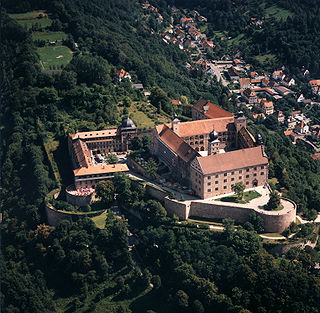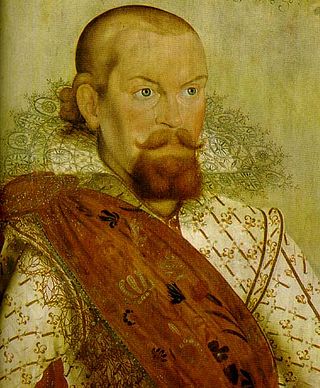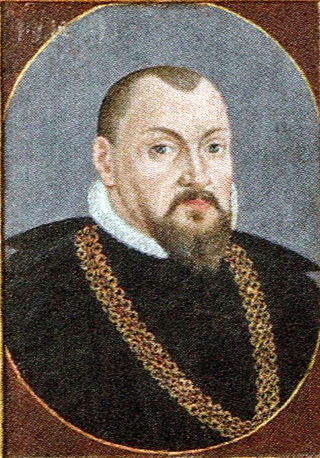
The House of Hohenzollern is a formerly royal German dynasty whose members were variously princes, electors, kings and emperors of Hohenzollern, Brandenburg, Prussia, the German Empire, and Romania. The family came from the area around the town of Hechingen in Swabia during the late 11th century and took their name from Hohenzollern Castle. The first ancestors of the Hohenzollerns were mentioned in 1061.

John II was Elector of Brandenburg from 1486 until his death, the fourth of the House of Hohenzollern. After his death he received the cognomen Cicero, after the Roman orator of the same name, but the elector's eloquence and interest in the arts is debatable.

Albrecht III was Elector of Brandenburg from 1471 until his death, the third from the House of Hohenzollern. A member of the Order of the Swan, he received the cognomen Achilles because of his knightly qualities and virtues. He also ruled in the Franconian principalities of Ansbach from 1440 and Kulmbach from 1464.

Brandenburg-Prussia is the historiographic denomination for the early modern realm of the Brandenburgian Hohenzollerns between 1618 and 1701. Based in the Electorate of Brandenburg, the main branch of the Hohenzollern intermarried with the branch ruling the Duchy of Prussia, and secured succession upon the latter's extinction in the male line in 1618. Another consequence of intermarriage was the incorporation of the lower Rhenish principalities of Cleves, Mark and Ravensberg after the Treaty of Xanten in 1614.

The Principality or Margraviate of (Brandenburg-) Ansbach was a free imperial principality in the Holy Roman Empire centered on the Franconian city of Ansbach. The ruling Hohenzollern princes of the land were known as margraves, as their ancestors were margraves.

The Principality of Bayreuth or Margraviate of Brandenburg-Bayreuth was an immediate territory of the Holy Roman Empire, ruled by a Franconian branch of the Hohenzollern dynasty. Since Burgrave Frederick VI of Nuremberg was enfeoffed with the Margraviate of Brandenburg in 1415/17, the Hohenzollern princes transferred the margravial title to their Franconian possessions, though the principality never had been a march. Until 1604 they used Plassenburg Castle in Kulmbach as their residence, hence their territory was officially called the Principality of Kulmbach or Margraviate of Brandenburg-Kulmbach until the Empire's dissolution in 1806.

Plassenburg is a castle in the city of Kulmbach in Bavaria. It is one of the most impressive castles in Germany and a symbol of the city. It was first mentioned in 1135. The Plassenberg family were ministerial of the counts of Andechs and used as their seat the Plassenburg. The House of Guttenberg, a prominent Franconian noble family, traces its origins back to 1149 with a Gundeloh v. Blassenberg (Plassenberg). The name Guttenberg is derived from Guttenberg and was adopted by a Heinrich von Blassenberg around 1310. From 1340, the Hohenzollerns governed from Plassenburg castle their territories in Franconia till 1604. The Plassenburg was fortress and residence for the Hohenzollerns.

Christian, Margrave of Brandenburg-Bayreuth was a member of the House of Hohenzollern and Margrave of Brandenburg-Kulmbach.

The Margraviate of Brandenburg was a major principality of the Holy Roman Empire from 1157 to 1806 that played a pivotal role in the history of Germany and Central Europe.

The Treaty of Pyritz settled claims of the House of Pomerania and the House of Hohenzollern regarding the legal status and succession in the Duchy of Pomerania on 26 and 28 March 1493. John Cicero, Elector of Brandenburg of the Hohenzollern renounced the Electorate of Brandenburg's claims to hold the Pomeranian duchy as a fief on 26 March in Pyritz. In turn, Bogislaw X, Duke of Pomerania acknowledged Brandenburgian succession in his duchy in case of the extinction of his dynasty on 28 March in Königsberg. The treaty was the most important achievement of Bogislaw X's foreign policy. It was confirmed and amended when a final settlement between the two houses was reached in the Treaty of Grimnitz in 1529.

Joachim II was a Prince-elector of the Margraviate of Brandenburg (1535–1571), the sixth member of the House of Hohenzollern. Joachim II was the eldest son of Joachim I Nestor, Elector of Brandenburg and his wife Elizabeth of Denmark, Norway, and Sweden. He received the cognomen Hector after the Trojan prince and warrior for his athel qualities and prowess.

Sophia of Poland, was a Polish princess, member of the Jagiellonian dynasty, great grand daughter of Emperor Sigismund and by marriage Margravine of Brandenburg-Ansbach and Brandenburg-Kulmbach.

The Treaty of Grimnitz was the final settlement of a long-standing dispute between the House of Pomerania and the House of Hohenzollern regarding the legal status and succession in the Duchy of Pomerania. It renewed and amended the Treaty of Pyritz of 1493.

Joachim Ernst, Margrave of Brandenburg-Ansbach was a German nobleman. He ruled as margrave of Brandenburg-Ansbach from 1603 to 1625, succeeding his cousin George Frederick and succeeded by his son Frederick III.
Henry V of Plauen was Burgrave of Meissen and Lord of Plauen and Voigtsberg.

Anna of Saxony was a princess of Saxony by birth and Electress of Brandenburg by marriage to Albrecht III Achilles, Elector of Brandenburg.

John of Brandenburg-Küstrin, was a member of the House of Hohenzollern and a Margrave of Brandenburg-Küstrin.

The Dispositio Achillea was the disposition of the territories of Elector Albert III Achilles of Brandenburg as regulated in his last will and testament of 1473.
The House Treaty of Regensburg was a treaty concluded on 23 July 1541 between two branches of the House of Hohenzollern, defining the boundaries between the newly created principalities of Ansbach and Kulmbach. These two territories had been created when in 1486 the Burgraviate of Nuremberg had been divided according to the Dispositio Achillea.
The German Emperors after 1873 had a variety of titles and coats of arms, which in various compositions became the officially used titles and coats of arms. The title and coat of arms were last fixed in 1873, but the titles did not necessarily mean that the area was really dominated, and sometimes even several princes bore the same title.















